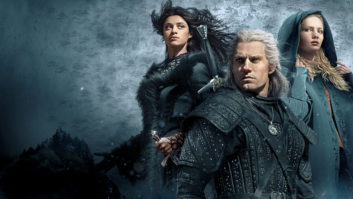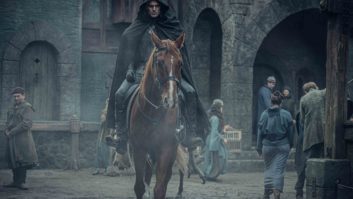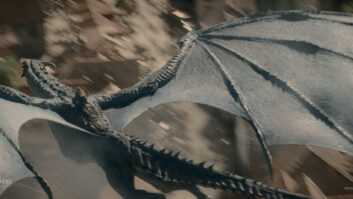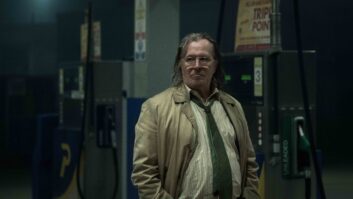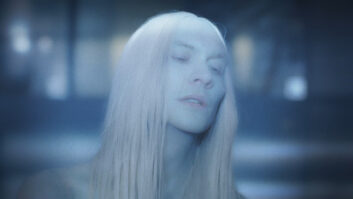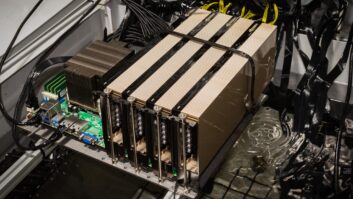Game of Thrones fans looking to fill the sorcery-shaped hole in their lives will likely have already diverted their energy into The Witcher, the new Netflix show starring Henry Cavill as Geralt the monster hunter. What they might not know is that creative studio Framestore completed 320 VFX shots for the series in the space of a year, mostly in the realm of environment building and magical effects.
“We had 99 people work on it overall, mostly based in London,” explains Christopher Gray, executive producer, television and advertising at Framestore. “When you look at the whole VFX force on it, it’s the equivalent of a big, Marvel kind of size movie really, and the amount of shots across the whole of season one is comparable to the first two Lord of the Rings films as an example. So when you see it through that lens it’s quite a large body of work to turn around within a year, while shooting and delivering the bulk of it actually in six months.”
The other vendors included Cinesite and Platige Image, the company responsible for cinematic work on the celebrated Witcher video games. “We have to share some assets and some work between the two of us, which is very common when you’re working on big shows,” says Pedro Sabrosa, VFX supervisor at Framestore. “Some of those elements we can’t share like rigs and stuff like that. So there are rules in place and a lot of that stuff gets ironed out early on to make sure that process is as seamless as possible.”
“Certain things are shareable and other things aren’t so easily shareable,” adds Gray. “We’ve done shows where another vendor has had to pick up a character of ours for instance, and they’ve had to essentially rebuild that character within their own pipeline in order to make it exact to the one we’ve built originally. To share shots you then figure out what the most universal application of those tools are and then you find that common ground and share it in a format that everybody can pick up and use.”
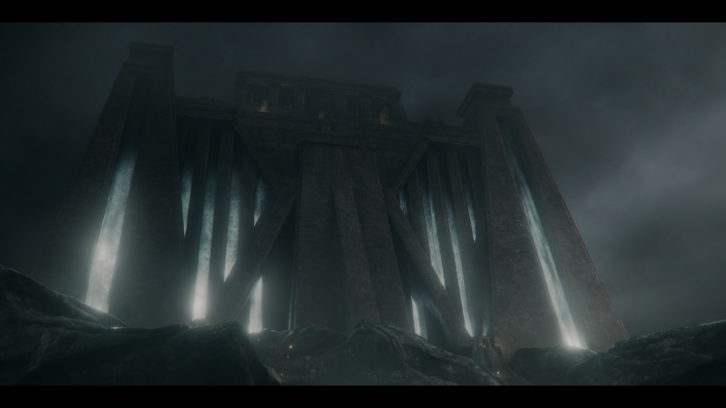
At Framestore’s end, the project was predominantly handled in Houdini, an appropriate name where the magic effects were concerned. “It’s definitely become the dominant package,” says Sabrosa. “Maya was the go-to for a lot of the work, a lot of that’s now shifted to Houdini and our pipeline has followed that as well. So that’s become our predominant go-to tool.”
Gray explains that showrunner Lauren Schmidt Hissrich wanted to see an in-world cost to these magical effects, meaning mages disintegrate when they use their powers. “That kind of effect utilises animation specialties as well, so we distort face shapes and actually animate the face to kind of shrink, and then there’s a simulation on top of that to give you the layers of the particle effects and the pieces falling off of her. So those multi-discipline things go into a shot like that.”
How does the team differentiate these disintegration effects from the kind we saw recently in (spoiler alert) the Avengers movies? “Fans and the public are quite discerning,” notes Gray, “and they’re going to go, ‘oh I’ve seen that before, it’s not as good as the effects in that movie,’ which had three times the budget to achieve it! But we do a lot of work with our art department so if a brief comes in we’ll go ahead and design variations of that, and then they’ll start to add subtleties.
“I think what’s great about Framestore is that because we have our own internal art department interpreting those briefs from the client side, they come through this net of all the shows we’ve ever worked on – you’ve got guys who’ve been here for 20 years and they’ve been designing the Avengers effects or the effects on this, that and the other,” he continues. “They can say, ‘well we want to avoid the look of that thing so if we do a little bit of this and we add these elements, it will create this similar but different thing,’ which is what everybody wants.”
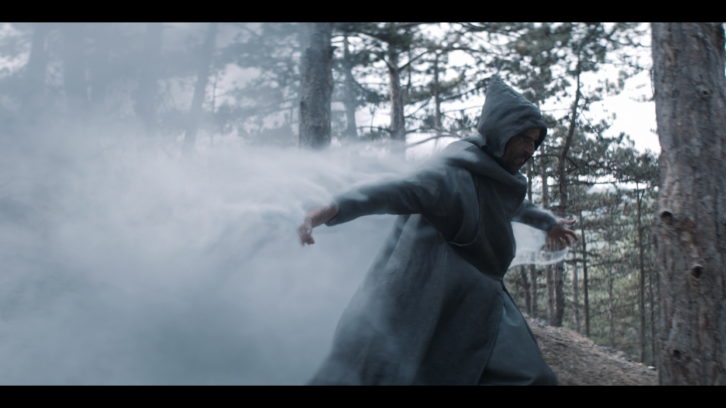
Sabrosa adds that Maya is still used in the case of character animation, and in building the city of Cintra, where Princess Ciri (Freya Allan) grew up. “That was a very large CG environment which we used Maya and CityEngine to help populate with thousands of buildings,” he says. “So we built a deck of different houses that we could then kind of munge together to build a huge variety of buildings. We built some accent buildings like churches and meeting halls, and the city was tiered in three different levels – we had the working class where all the factories and people work and live; we had the middle class where your bankers would live and your senior military; and then we had the royal tier at the top. So a lot of time and effort and design and technology went into finding efficient ways of building and laying out a city as well as designing it.”
“Also the scale of it expanded as the season developed,” adds Gray, “because they shot new scenes in Cintra, and we built it compartmentalised and expandable – and because we did that we were able to expand it when it was necessary later on when those scenes were added, seeing different views and different vantage points of the city.
“Design never really finishes because on a first season of a big world-building show you are constantly increasing the scale and changing things about the environment,” he continues. “I think what’s interesting as we get edits through is our effects work also feeds into the storytelling in certain sequences where continuity is important, or the size of certain effects needs to be more subtle or bigger – those things have got real opportunities to dial in the nuances and really aid the storytelling on big moments, and we were really grateful not just to do lots of environment work across the board, but tackle lots of key moments really across the season, really beautiful moments that people will remember.”
This allows tweaks to occur right down to the wire, with episodes delivered to Netflix a month before they’re released on the platform. “Ten to 15 years ago when it was prints that were going out, of course you had to have a huge cut-off, a huge lead time to get the release out the door and get all your prints made and everything like that,” Gray observes. “So I think we’re in that world now where it’s feasibly possible to even overwrite a particular bit of any master file on a server somewhere, but they don’t like to do that, for obvious reasons – and there’s obviously marketing and all the localisation, so there is a cut-off and I think we probably pushed it as far as we possibly could on this particular show!”
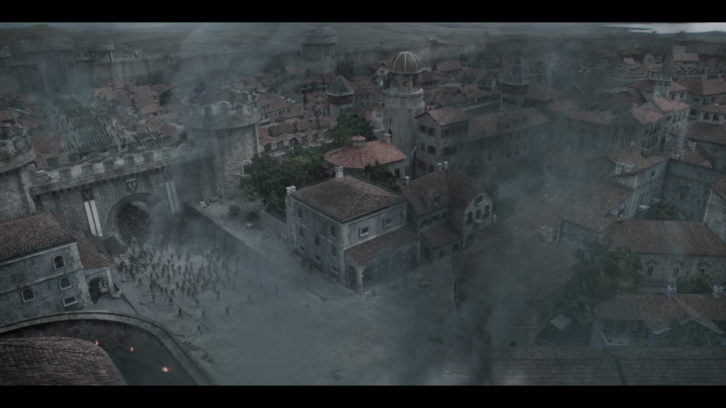
Netflix also introduces the requirement of 4K, thereby quadrupling the resources used by the studio. “They’ve set a new norm really, Netflix, in the 4K space,” says Gray. “Going back five years that was a particularly tricky thing for everybody who works in a technological space with storage and rendering and processing power and all those things really pushing the edge. I think it was bold of Netflix to really mandate the 4K thing and that drove the quality and the technical needs with regard to cinematography as well… we’ve worked on all the big shows that all the streamers are doing this year and they’re all working at 4K – that’s the standard now, like it or lump it, that’s where it’s at, that’s the quality threshold that everybody wants to make their work at.
“Whether or not people can view it in 4K at home, which most people can’t, is another thing but look, give it five years, most people will probably have 4K TVs,” he continues. “So I think that technological revolution is really interesting and of course we’ve had to adapt to that and it has lots of implications for us in every stage – our assets need to be more detailed, our rendering takes a lot longer to do, our comp work is slower. But I think the onus is on us then to invest and support that process and upgrade our hardware and create efficiencies for our artists to work in that space. It’s great because it creates a more competitive environment and it keeps everybody on their toes, which is really interesting – but it’s not without its challenges.”
“No it certainly isn’t,” Sabrosa agrees. “It definitely pushes everyone to the edge sometimes, but it pays off because there’s more scrutiny on the work, there’s a bigger canvas that you’re working on, so everything has to look better and so it pushes us technologically and also creatively.”
There’s not much time for Framestore to take its foot off the gas as Netflix has recently announced a second season of The Witcher. “There’s a lot of stuff that’s been set up in season one that acts as a springboard,” says Sabrosa, “little things that have been hinted at, little parts of the city that we’ve seen from afar that we can then build upon, lots of payoffs that need to come through in season two that have been established. A lot of the heavy lifting has been done in season one, it’s great to be able to go on to another season and expand on that.”
